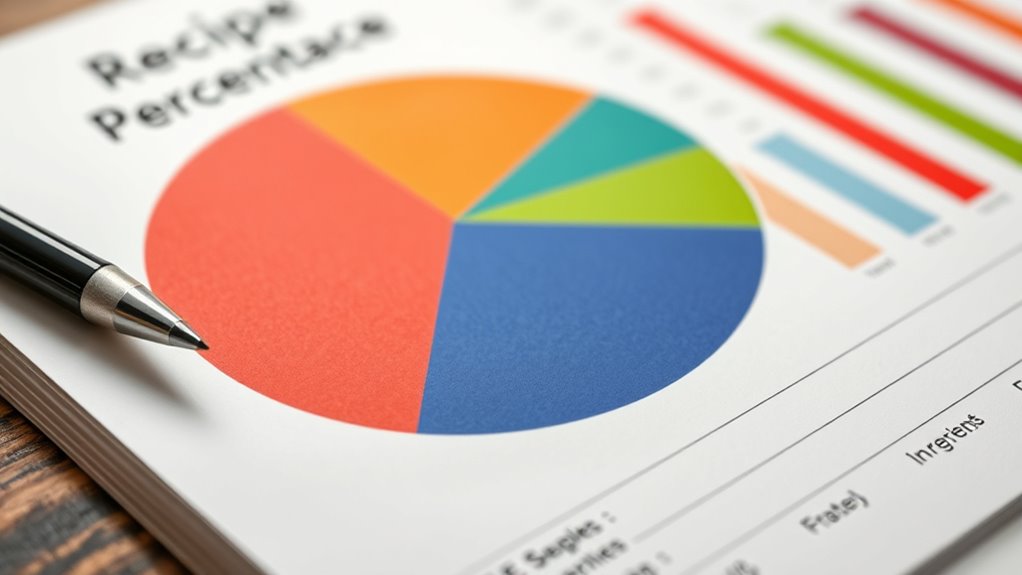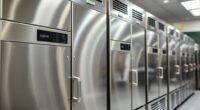Yield percentage in recipe costing shows how much usable product you get from raw ingredients after processing. It’s calculated by dividing the cooked or prepared weight by the original raw weight, then multiplying by 100. This figure helps you set accurate costs, price dishes correctly, and control waste. Understanding yield allows you to identify loss points and improve efficiency. Keep exploring how managing yield can boost your profitability and optimize your kitchen operations.
Key Takeaways
- Yield percentage indicates the usable product obtained from raw ingredients after processing.
- It is calculated by dividing the cooked or processed weight by the raw weight and multiplying by 100.
- Accurate yield data helps determine the true cost of ingredients and ensures proper recipe costing.
- Adjusting ingredient costs based on yield prevents underestimating expenses and maintains profit margins.
- Monitoring yield variations allows for process improvements, reducing waste and optimizing recipe profitability.
What Is Yield Percentage and Why Does It Matter?
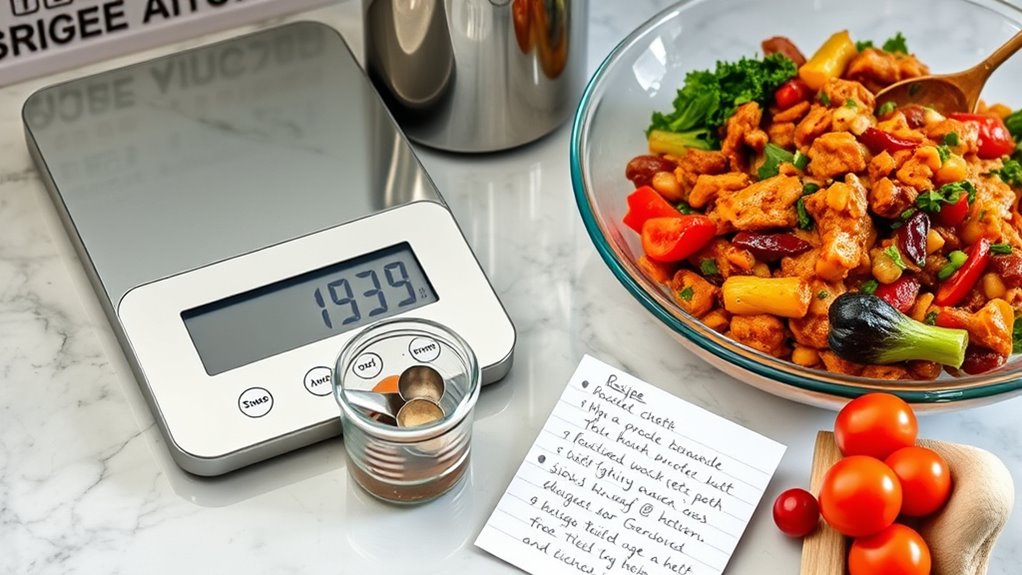
Have you ever wondered why some recipes turn out more cost-effective than others? That’s where yield percentage comes in. It’s a measure of how much usable product you get from your raw ingredients after cooking or processing. For example, if you start with 10 pounds of chicken and end up with 8 pounds of cooked meat, your yield percentage is 80%. This number helps you understand how efficiently ingredients are being converted into the final dish. Proper storage techniques can also influence the yield by minimizing spoilage and waste. Why does it matter? Because it directly impacts your food costs and profit margins. A higher yield means less waste and more value from your ingredients. Knowing your yield percentage allows you to price dishes accurately and manage costs effectively, ensuring your business stays profitable.
How to Calculate Yield Percentage Accurately
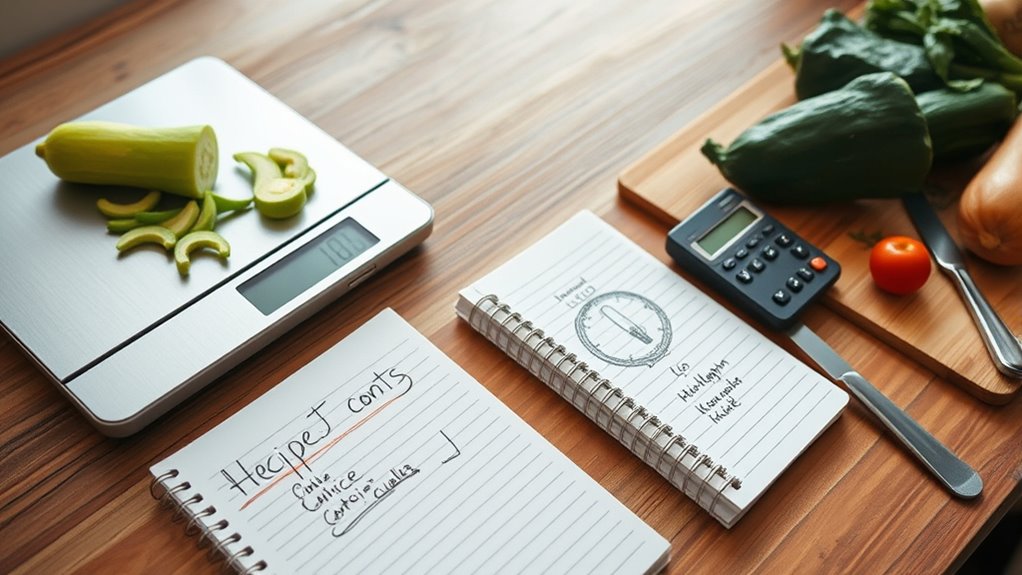
Calculating yield percentage accurately involves a straightforward formula that compares the edible portion of your cooked or processed ingredients to their raw weight. To do this, weigh the raw ingredient before cooking or processing. After preparation, weigh the remaining edible portion. Divide the cooked or processed weight by the raw weight, then multiply by 100 to get the yield percentage. For example, if you start with 100 grams of raw chicken and after cooking, you have 75 grams of edible meat, your yield percentage is 75%. This calculation helps you determine how much usable product you get from raw ingredients. Make sure to weigh ingredients carefully and consistently to ascertain your yield percentage is accurate, which is essential for precise recipe costing and inventory management. Additionally, understanding spiritual practices can promote mindfulness and focus, leading to more consistent measurements and better overall management of your kitchen operations.
Common Factors That Affect Yield in Food Preparation
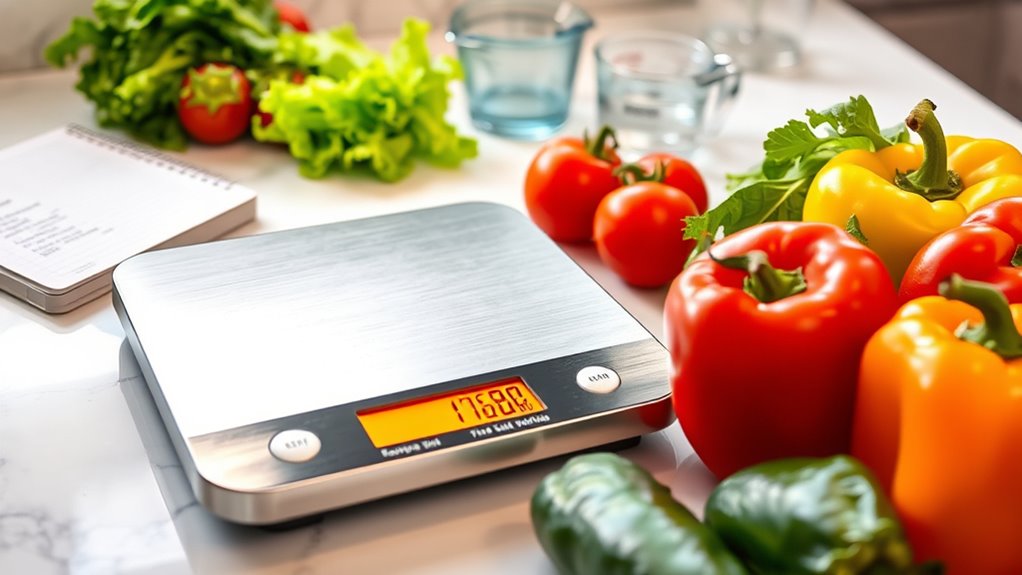
Your ingredient quality can vary, directly impacting how much usable product you get after preparation. The cooking method you choose also plays a role, as some techniques can cause more loss or retention of yield. Understanding these factors helps you better control your recipe costs and optimize your results. Additionally, applying ethical hacking principles can be useful for identifying vulnerabilities in your kitchen’s inventory management systems, ensuring data security and preventing theft.
Ingredient Quality Variability
Ingredient quality variability is a key factor that can considerably impact yield in food preparation. When ingredients differ in freshness, size, or ripeness, the amount of edible product you get can vary markedly. For example, older or less fresh produce may have more waste or lower weight after peeling or trimming. Larger or unevenly sized items may require more waste removal, reducing usable portions. Variations in ingredient quality also affect how much of the ingredient actually contributes to your final dish’s weight and flavor. If you start with subpar or inconsistent ingredients, your yield percentage drops, and your recipe’s cost efficiency suffers. Ensuring consistent, high-quality ingredients helps stabilize your yields, making your food preparation more predictable and cost-effective. Additionally, selecting ingredients with uniform size and ripeness minimizes waste and maximizes usable yield.
Cooking Method Impact
Cooking methods considerably influence yield because different techniques can cause moisture loss, structural changes, and flavor alterations. For example, roasting and grilling often result in significant moisture evaporation, reducing the final weight. Boiling or braising, on the other hand, can lead to nutrient and juice leaching into the cooking liquid, decreasing yield if the liquids aren’t recovered. Searing meat causes moisture loss at the surface, affecting overall weight and tenderness. Techniques involving dehydration, like baking or drying, intentionally reduce moisture, lowering yield but concentrating flavors. Additionally, pressure cooking can tenderize ingredients while preserving more moisture if managed carefully. Understanding how each method impacts moisture retention and structural integrity helps you predict yield variations and control costs more effectively in recipe preparation. Cooking techniques play a vital role in determining final product weight and quality.
Applying Yield Percentage to Costing and Pricing Strategies
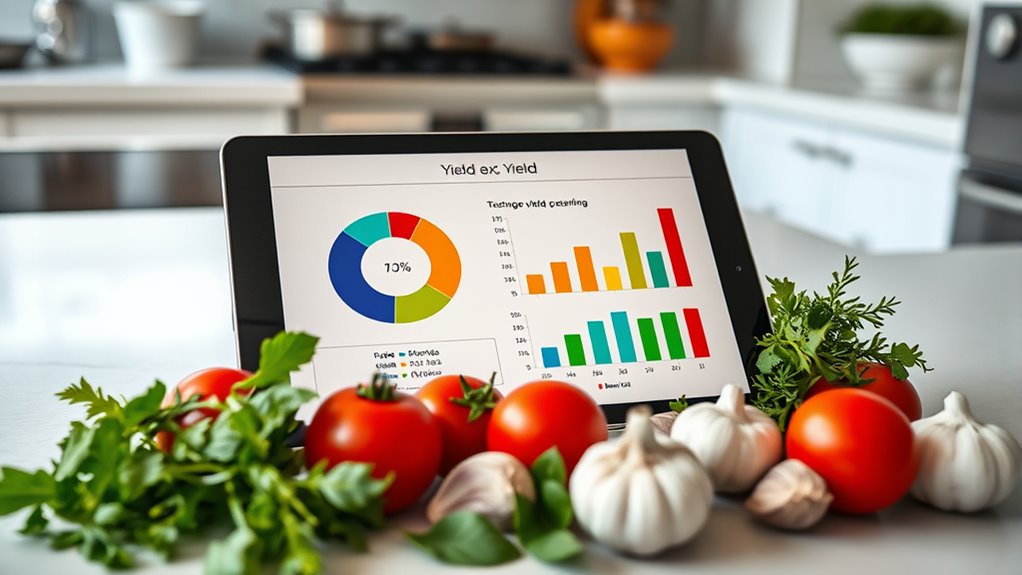
Understanding how to apply yield percentage to costing and pricing strategies is essential for accurately determining the true cost of your finished products. By adjusting ingredient costs based on yield, you ensure that your prices reflect the actual amount of usable product. For example, if a recipe’s yield is 80%, you divide the raw ingredient cost by 0.8 to find the true cost per usable unit. This prevents underestimating expenses and helps set realistic profit margins. Incorporating yield percentage into your pricing strategy also allows you to compare different suppliers or recipes objectively. It encourages precise cost management and guarantees your prices cover all expenses, including losses during processing. Additionally, understanding pet hair management can help you maintain a cleaner workspace, indirectly affecting operational costs. Ultimately, understanding and applying yield percentage helps you price your products competitively while safeguarding profitability.
Tracking and Improving Yield for Better Profitability
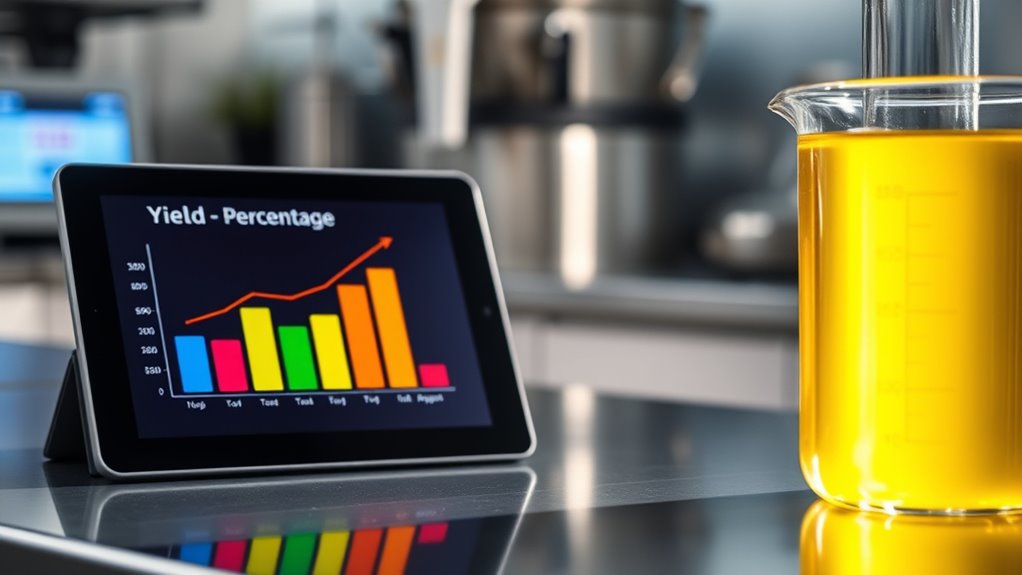
Tracking and improving yield is essential for maximizing profitability because it directly impacts the amount of usable product you produce from each batch. By closely monitoring your yield, you identify where losses occur and take targeted actions to reduce waste. Consistently recording yield data helps you spot patterns and inefficiencies, such as over-portioning or ingredient spoilage. To improve yield, focus on refining your processes, training staff to handle ingredients properly, and adjusting recipes for better efficiency. Small improvements in yield can substantially boost your profit margin over time. Regularly reviewing your yield data allows you to make informed decisions that optimize ingredient usage, reduce costs, and increase overall profitability. Additionally, understanding wall organization systems can help streamline kitchen storage and reduce ingredient spoilage, further enhancing yield. Continuous tracking ensures you stay proactive in maximizing every batch’s potential.
Tools and Techniques for Managing Yield in Your Kitchen
Implementing standardized portion sizes helps guarantee consistency and reduces waste in your kitchen. Regularly tracking yield gives you clear insights into where improvements are needed. Together, these tools can optimize your recipe costs and boost profitability.
Standardized Portion Sizes
Standardized portion sizes are essential tools for managing yield and ensuring consistency in your kitchen. They help control costs, minimize waste, and deliver uniform customer experiences. By defining exact portion weights or servings, you can accurately track ingredient use and maintain quality standards. To implement this effectively, create a clear portioning system. Use measuring tools, such as scales or scoop sizes, and document standard portions for each dish. Here’s a simple example:
| Dish | Standard Portion | Servings per Batch |
|---|---|---|
| Pasta Salad | 150g | 20 |
| Roast Chicken | 200g | 15 |
| Fruit Salad | 100g | 25 |
This table guarantees everyone follows the same portion size, optimizing yield and controlling food costs.
Regular Yield Tracking
Maintaining accurate records of your yield helps you identify discrepancies between expected and actual ingredient use, enabling better control over costs. Regular yield tracking involves consistently measuring ingredient outputs after each process to ensure efficiency. Use digital tools like spreadsheets or specialized software to log data over time, making it easier to spot trends or issues. Establish routines for recording yields at key stages, such as prep, cooking, and plating. Comparing these records against your standard yields highlights shrinkage or wastage. By monitoring yield regularly, you can adjust portion sizes, improve processes, and reduce costs. Consistent tracking also helps train staff on proper handling and portioning, fostering accountability. Regular yield tracking may also reveal the impact of Glycolic Acid Benefits for Skin on ingredient quality, especially when handling sensitive or exfoliated ingredients. Ultimately, diligent yield management keeps your kitchen profitable and ensures your recipes remain cost-effective.
Frequently Asked Questions
How Does Yield Percentage Vary Across Different Cuisines?
You might notice that yield percentage varies widely across different cuisines because of ingredient types and preparation methods. For example, cuisines using whole cuts or minimal processing, like steakhouses, often have higher yields. In contrast, cuisines involving lots of peeling, trimming, or cooking loss, like baking or frying, tend to have lower yields. Understanding these differences helps you accurately estimate costs and portion sizes for each cuisine.
What Are the Common Mistakes in Calculating Yield Percentage?
When you calculate yield percentage, you often make mistakes like forgetting to account for waste or trim loss. You might also use inconsistent weights or measure ingredients differently from the recipe instructions. Additionally, not recording actual yields over time can lead to inaccurate calculations. To improve, double-check your measurements, track waste accurately, and make certain you’re using the same methods each time for consistent results.
Can Yield Percentage Be Standardized for All Recipes?
Imagine trying to fit every recipe into one perfect mold—sounds impossible, right? You can’t standardize yield percentages for all recipes because each dish varies wildly. Factors like ingredient quality, cooking methods, and portion sizes affect yield. Instead, you should customize yield calculations for each recipe to get accurate costing. This approach saves you money and keeps your menu consistent, no matter how diverse your dishes are.
How Does Ingredient Quality Impact Yield Percentage?
Ingredient quality substantially impacts yield percentage because higher-quality ingredients often result in better extraction, less waste, and increased usable output. When you use fresh, premium ingredients, you’re more likely to maximize yield, whereas lower-quality items may break down or spoil more easily, reducing your overall yield. By choosing quality ingredients, you guarantee more consistent results and improve your recipe’s efficiency, ultimately saving costs and enhancing flavor.
What Training Is Recommended for Kitchen Staff on Yield Management?
You should train your kitchen staff on proper yield management to optimize efficiency and reduce waste. Focus on techniques like precise portioning, proper handling, and storage of ingredients. Conduct hands-on workshops, emphasize the importance of accurate measurements, and encourage consistent practices. Regular refresher courses help maintain standards. By empowering your team with knowledge and skills, you ensure better yield control, lower costs, and improved overall kitchen performance.
Conclusion
Understanding and managing yield percentage is key to accurate recipe costing and boosting your profits. By tracking and improving your yields, you guarantee less waste and better pricing strategies. Remember, “A penny saved is a penny earned,” so mastering yield helps you cut costs without sacrificing quality. Keep refining your processes, stay attentive to factors affecting yield, and watch your profitability grow. With these tools, you’ll turn every ingredient into maximum value.
